Question
Reproduction in eukaryotes can be sexual or asexual.
Describe the origin of eukaryotic cells according to the endosymbiotic theory.
Explain how hormones are used to control the human menstrual cycle.
Outline natural methods of cloning in some eukaryotes.
▶️Answer/Explanation
Markscheme
a. mitochondria and chloroplasts are similar to prokaryotes
b. «host» cell took in another cell by endocytosis/by engulfing «in a vesicle»
Allow “taking in” in place of “engulfing”
c. but did not digest the cell/kept the «ingested» cell alive
OR
symbiotic/mutualistic relationship «between engulfed and host cell»
d. chloroplasts and mitochondria were once independent/free-living «organisms»
e. DNA «loop» in chloroplast/mitochondrion
f. division/binary fission of chloroplast/mitochondrion
g. double membrane around chloroplast/mitochondrion
h. 70s ribosomes «in chloroplast/mitochondrion»
Award up to [2] for evidence from mpe to mph
[Max 4 Marks]
a. FSH stimulates the development of follicles
b. follicles produce estrogen
c. estrogen stimulates the repair of the uterus lining
d. estrogen stimulates LH secretion
e. LH causes/stimulates ovulation
f. LH causes/stimulates the development of the corpus luteum
g. corpus luteum secretes progesterone
h. progesterone causes/stimulates thickening of the uterus lining
OR
prepares uterine lining for implantation
OR
maintains the endometrium
i. progesterone/estrogen inhibits the secretion of LH/FSH
j. falling progesterone levels at the end of the cycle allow FSH production/menstruation
k. negative/positive feedback «control» described correctly
l. LH/FSH are pituitary hormones
[Max 8 Marks]
a. clones are genetically identical organisms
OR
group of cells derived from a single parent cell
b. asexual reproduction in plants such as tubers/runners/bulbs
Allow other verifiable examples of plants
c. common in non-vertebrates such as budding in hydra
Allow other verifiable examples of invertebrates
d. budding in yeast/fungi
Allow other verifiable examples of fungi
e. identical twins «in humans» are clones because they originate from
the same cell
Question
The figure shows a transmission electron micrograph of rotavirus particles. Each rotavirus is about 70 nanometres in diameter.
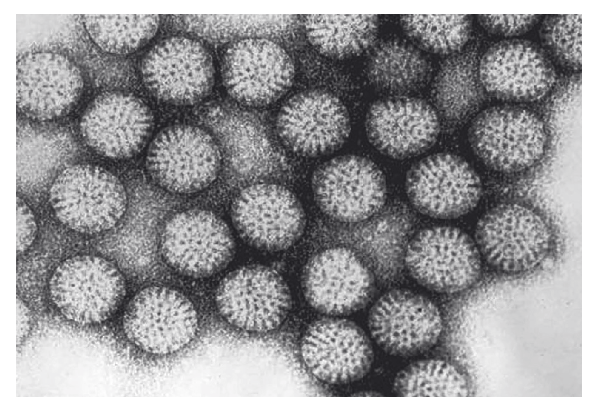
[Source: CDC / Dr. Erskine L. Palmer]
State a reason for using an electron microscope to view this virus rather than a light microscope.
Rotavirus causes diarrhea and vomiting. Explain why viral diseases cannot be treated using antibiotics.
State an application of plasmids in biotechnology.
▶️Answer/Explanation
Markscheme
electron microscope has greater resolution/magnification
OR
70 nm is too small/viruses are too small to be viewed by a light microscope
a. viruses are not living
b. viruses lack metabolism/lack enzymes «for metabolism»/lack cell walls
c. antibiotics target metabolic «pathways»/cell wall production
[Max 2 Marks]
transfer/vector of genetic material/genes/DNA fragments
OR
to produce insulin/useful protein
Question
DNA research, involving biotechnology, has led to benefits for society but has given rise to some controversy.
Outline how translation depends on complementary base pairing.
Describe the polymerase chain reaction (PCR), including the role of Taq DNA polymerase.
Explain benefits and risks of using genetically modified crops for the environment and also for human health.
▶️Answer/Explanation
Markscheme
a. translation converts a sequence of mRNA nucleotides/codons to a sequence of amino acids/polypeptide/protein
b. «triplets of» nucleotides/bases on «activated» tRNAs pair with complementary «triplets of» nucleotides/bases on mRNA / vice versa
c. base pairing occurs when adenine/A pairs with uracil/U and guanine/G pairs with cytosine/C
d. specific amino acids are attached to specific of tRNA
e. mRNA has codons AND tRNA has anticodons
a. PCR is process by which a small sample of DNA can be amplified/copied many times
b. PCR involves repeated cycling through high and lower temperatures «to promote melting and annealing of DNA strands»
c. «mixture» is heated to high temperatures to break «hydrogen» bonds between strands of DNA/to separate the double-stranded DNA
d. Taq DNA polymerase can withstand high temperatures without denaturing
e. primers bind to «targeted» DNA sequences at lower temp
f. Taq DNA polymerase forms new «double-stranded» DNA by adding «complementary» bases/nucleotides
Environment benefits:
a. pest-resistant crops can be made
b. so less spraying of insecticides/pesticides
c. less fuel burned in management of crops
d. longer shelf-life for fruits and vegetables so less spoilage
e. greater quantity/shorter growing time/less land needed
f. increase variety of growing locations / can grow in threatened conditions
Environment risks:
g. non-target organisms can be affected
h. genes transferred to crop plants to make them herbicide resistant could spread to wild plants making super-weeds
i. GMOs (encourage monoculture which) reduces biodiversity
j. GM crops encourage overuse of herbicides
Health benefits:
k. nutritional value of food improved by increasing nutrient content
l. crops could be produced that lack toxins or allergens
m. crops could be produced to contain edible vaccines to provide natural disease resistance
Health risks:
n. proteins from transferred genes could be toxic or cause allergic reactions
o. antibiotic resistance genes used as markers during gene transfer could spread to «pathogenic» bacteria
p. transferred genes could cause unexpected/not anticipated problems
OR
health effects of exposure to GMO unclear
Question
Genetic engineering allows genes for resistance to pest organisms to be inserted into various crop plants. Bacteria such as Bacillus thuringiensis (Bt) produce proteins that are highly toxic to specific pests.
Stem borers are insects that cause damage to maize crops. In Kenya, a study was carried out to see which types of Bt genes and their protein products would be most efficient against three species of stem borer. The stem borers were allowed to feed on nine types of maize (A–I), modified with Bt genes. The graph below shows the leaf areas damaged by the stem borers after feeding on maize leaves for five days.
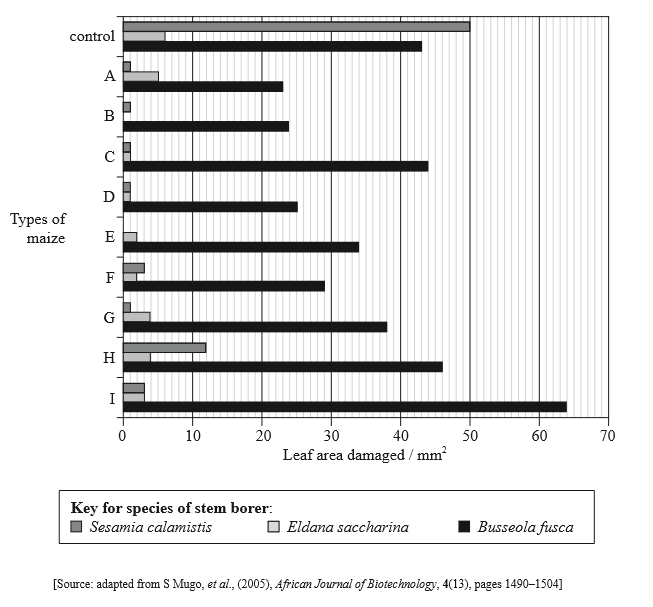
Before the use of genetically modified maize as a food source, risk assessment must be carried out. A 90-day study was carried out in which 3 groups of 12 adult female rats were fed either:
• seeds from a Bt maize variety
• seeds from the original non-Bt maize variety
• commercially prepared rat food.
All the diets had similar nutritional qualities.
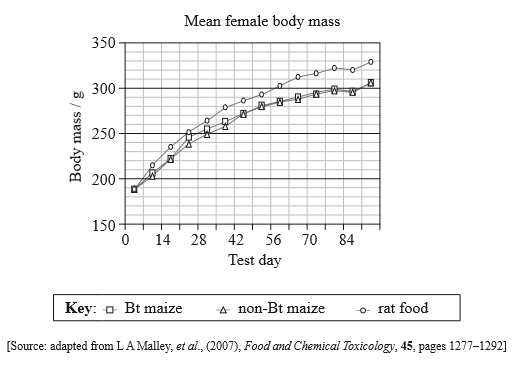
State what would be used as the control in this experiment.
Outline the effects of the three species of stem borer on Bt maize type A.
Evaluate the efficiency of the types of Bt maize studied, in controlling the three species of stem borers.
Describe the change in mean mass for the female rats during the 90-day experiment.
Evaluate the use of Bt maize as a food source compared to the other diets tested.
▶️Answer/Explanation
Markscheme
maize not modified/transformed with Bt (genes) / maize that did not have Bt gene added / not genetically modified / untreated maize
there was a decrease in damage by all three types of stem borers compared to control;
there was almost no change in damage by Eldana compared to control;
there was almost no damage/little effect (to Bt maize type A) by Sesamia (and Eldana);
Busseola caused the most damage (to Bt maize type A);
very efficient at controlling Sesamia;
type B is the most effective against the three stem borers collectively;
no type of Bt maize controlled Busseola well / vice versa i.e. Busseola not well controlled by any types of Bt maize;
all types of Bt maize decreased Sesamia damage (significantly) / Bt maize type E not damaged by Sesamia / vice versa;
Bt maize types C/H/I had more damage caused by Busseola (than was caused in the control) / vice versa;
all types of Bt maize decreased Eldana damage (to some extent) / type B was not damaged by Eldana / vice versa;
Eldana damage low in control / less effect;
cannot determine efficiency since data is about leaf damage and stem borers may feed (preferentially) on other structures/stems/roots;
mass increases in all three groups;
increase is more rapid in beginning and tapers off later in the study;
mass seems to be levelling off in rats fed Bt and non-Bt maize / rate of increase in mass is slowing down;
rats fed rat food always have higher mass/greater mass increase than those fed either type of maize;
all three foods result in the same pattern of growth/mass gain / highest rate of growth at start of study / tapering off later in the study;
Bt maize causes same amount of growth as non-Bt maize / appears to be as good a food source as non-Bt maize / there is no significant difference between Bt and non-Bt maize (in terms of mass gain);
corn (both types) appears to cause less growth/mass gain than rat food / vice versa;
genetic modification does not affect growth/mass gain;
no evidence to support risk of Bt maize to growth/mass gain;
study does not investigate other possible risks of Bt maize to rats;
sample size is small / only 12 rats (in each group) so this may not be enough to give trends;
only female rats tested, no males;
Question
The diagram shows the molecular structure of the amino acid leucine.
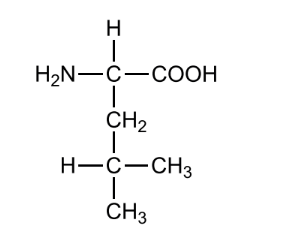
(a) Draw a circle on the diagram to enclose the carboxyl group. [1]
(b) State one protein that acts as a hormone. [1]
(c) Explain how enzymes are used in the preparation of milk suitable for individuals who are lactose intolerant. [2]
▶️Answer/Explanation
a
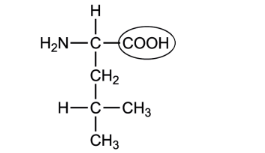
b insulin/glucagon/ADH/oxytocin/leptin / other verified example;
c a. the enzyme lactase acts on lactose;
b. the enzymes are immobilised / are bound to alginate beads;
c. (pouring milk over the immobilised enzymes) causes lactose to be hydrolysed/broken down into monosaccharides/glucose and galactose;
